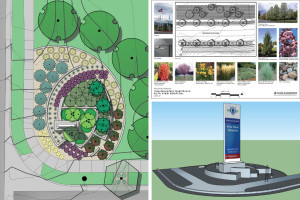Reasons our future depends on landscape architecture
 Earth’s landscape provides the fundamental support system for all of life. For billions of years, our landscape was and continues to be shaped by the interaction of natural forces and life itself. Since human civilization began some 6,000 years ago, we’ve made some significant transformations to our surroundings. Places like New York’s Central Park, the Vaux le Vicomte in France give a peek into our species’ creative imagination to shape the landscape in ways not even nature is capable of.
Earth’s landscape provides the fundamental support system for all of life. For billions of years, our landscape was and continues to be shaped by the interaction of natural forces and life itself. Since human civilization began some 6,000 years ago, we’ve made some significant transformations to our surroundings. Places like New York’s Central Park, the Vaux le Vicomte in France give a peek into our species’ creative imagination to shape the landscape in ways not even nature is capable of.
But how would the future look like? The truth is it’s almost impossible to know. But with the ever-growing population (currently about 7.8 billion), we know that our actions will continue to greatly impact the planet. Solving many of the arising problems requires a multidisciplinary approach, but this post focuses on the role landscape architects will have in shaping that future.
- Climate Change
No one can doubt the impact our actions have had on the planet for the past three centuries. As we begin to concretely experience the negative impacts of climate change and global warming, including rising sea levels, affected water systems, disruption of weather patterns, and rising temperatures, we must adapt effectively to these changes if we are to thrive.
Landscape architects will continue to remain pivotal in our adaption process. Through their imagination, they will help create spaces that are better equipped to withstand the changing climate. But more importantly, they’ll help protect, enhance, and regenerate lost or fragile ecosystems.
- Sustainable Transport
One of the major problems of cities is ineffective transport systems. There are 274 registered cars in the United States – that’s more than the number of adults over 18 years old. With the dwindling supply of oil, it’s high time to rethink how public transportation can be more efficient. It’s also high time to consider how cities can be more walkable strongly.
Hence, public transport and pedestrian prioritization are the keys to a sustainable future. Who else can we turn to accomplish that than landscape architects? With their creativity and expertise, they’ll create better pedestrian cities with pleasurable public transport systems.
- Preservation and Restoration of Historic Sites
Part of what makes us human is the creation of cultural landscapes like formal gardens and parks. Similarly, heritage sites like the Pyramids of Giza or the Stonehenge in England are unique creations of humans. As the world changes in fundamental ways, we must preserve these significant sites as they reveal our cultural origins and pursuits. Landscape architects will play a crucial role in helping us preserve the integrity of many of these sites.
- Mental Health
There’s something innate within us that gets aroused when we get entrenched in the tranquility of nature itself. That’s precisely why urban parks, gardens, beaches, and many other outdoor spaces help with relaxation.
With our current fast-paced lives, it’s intriguing to imagine if those in the future would lead even faster lives. If that’s the case, then preserving mental health becomes more important than ever before.
As cities become more crowded, landscape architects will play a crucial role in creating spaces to help inhabitants take a break. The landscapes they create will serve as a ground for people to connect with nature and preserve their mental health.
- Social Integration
In less than three decades, the world is now connected than ever before – thanks to the internet. While we boast of diversity and multiculturalism, the truth is there are fewer opportunities for urban dwellers to form meaningful connections even with the person next door. We are all fixated on our phones, getting into mindless interactions most of the time.
Landscape architects carry the heavy burden of creating vibrant and welcoming destinations that will help humans from all walks of life interact in a traditional sense. And with what has been achieved by creating sites like Bryant Park, I’m convinced they are up to the task.
- Food
If not for the revolution in technology and agriculture, there’s no conceivable way we would be able to sustain our population. But the human population keeps growing at an exponential rate. Conservative projections indicate the world population to hit 9.7 billion by 2050 – the majority of which will come from developing countries. How would we sustain our global food system?
I believe landscape architects have a role to play as all humans have a shared connection to food. Landscape architects are the key to fostering cultural awareness of food towards more reliant food systems. They’ll also help promote maximum food self-sufficiency.
Wrap Up
While we do not know exactly how the future will be, we are confident that landscape architects will play a strong role in shaping it. As they apply their expertise and creativity to solve these problems, we hope that humanity’s future is all for the better.
Contact us today for more details.

